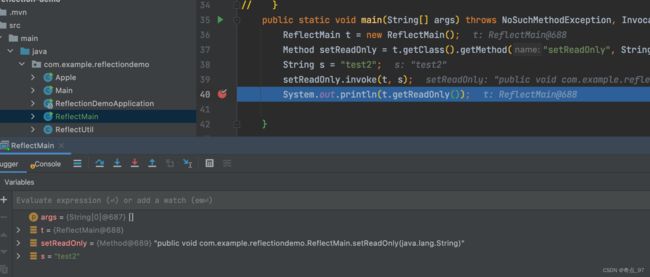java使用反射给对象属性赋值
哈喽!大家好,我是「奇点」,江湖人称 singularity。刚工作几年,想和大家一同进步
一位上进心十足的【Java ToB端大厂领域博主】!
喜欢java和python,平时比较懒,能用程序解决的坚决不手动解决
✨ 如果有对【java】感兴趣的【小可爱】,欢迎关注我
❤️ ❤️ ❤️感谢各位大可爱小可爱! ❤️ ❤️ ❤️
————————————————
如果觉得本文对你有帮助,欢迎点赞,欢迎关注我,如果有补充欢迎评论交流,我将努力创作更多更好的文章。
最近项目中遇到一个问题,就是能实现一个类将以后的多语都进行转换的通用方法,根据这个需求,决定使用反射实现,根据反射给对象属性设置属性值,下面是使用反射实现对对象属性值进行设置的方法
方法1:这里使用了Field的set方的 Field 属性,然后设置可见性,然后设置了一个值,最后打印
// 给变量赋值 给object对象的某个字段赋值
f.set(object, value);
//拿到了Field类的实例后就可以调用其中的方法了
//方法:get(Object obj) 返回指定对象obj上此 Field 表示的字段的值
package com.example.reflectiondemo;
import java.lang.reflect.Field;
/**
* @program my-project-model
* @description:
* @author: lee
* @create: 2023/01/04 19:52
*/
public class ReflectMain {
private String readOnly;
public String getReadOnly() {
return readOnly;
}
public void setReadOnly(String readOnly) {
System.out.println("set");
this.readOnly = readOnly;
}
public static void main(String[] args) throws NoSuchFieldException, IllegalAccessException {
ReflectMain t = new ReflectMain();
Field f = t.getClass().getDeclaredField("readOnly");
f.setAccessible(true);
f.set(t, "test");
System.out.println(t.getReadOnly());
}
}
方法2:使用invoke方法
package com.example.reflectiondemo;
import java.lang.reflect.Field;
import java.lang.reflect.InvocationTargetException;
import java.lang.reflect.Method;
/**
* @program my-project-model
* @description:
* @author: lee
* @create: 2023/01/04 19:52
*/
public class ReflectMain {
private String readOnly;
public String getReadOnly() {
return readOnly;
}
public void setReadOnly(String readOnly) {
System.out.println("set");
this.readOnly = readOnly;
}
// public static void main(String[] args) throws NoSuchFieldException, IllegalAccessException {
// ReflectMain t = new ReflectMain();
// Field f = t.getClass().getDeclaredField("readOnly");
// f.setAccessible(true);
// f.set(t, "test");
// System.out.println(t.getReadOnly());
//
// }
public static void main(String[] args) throws NoSuchMethodException, InvocationTargetException, IllegalAccessException {
ReflectMain t = new ReflectMain();
Method setReadOnly = t.getClass().getMethod("setReadOnly", String.class);
String s = "test2";
setReadOnly.invoke(t, s);
System.out.println(t.getReadOnly());
}
}
由此可见,使用反射我们能给很容易的给各个属性进行设置,即使是private的属性我们也能很轻松的设置属性值,下面利用这个demo例子,就设置了我们的最初的功能。
总结:
也就是说,第一种方法,没有调用属性的set方法就完成了赋值,
但是第二种方法,是通过调用属性的set方法来完成赋值。
所以,如果想在程序中改变程序的属性的值的同时还想做一些额外的事情,可以将这些事情写到set方法中并使用第二种方法
public class MultiLangContentUtil {
/**
* 从PO查询数据赋值到DTO
* 注意!!这里的多语字段根据
* 简体中文的变量名 英文名和繁体名需要根据规则进行 指定
* 规则如下
* 英文名=简体中文名2
* 繁体名=简体中文名3
*
* @param targetPO 数据库中查询出的数据
* @param targetDTO 将要转换的对象DTO
* @param targetMultiName 需要展示的多语字段
* @throws NoSuchFieldException
* @throws IllegalAccessException
*/
public static void setMultiLangDTOName(Object targetPO, Object targetDTO, String targetMultiName) {
try {
String locale = MultiLangContentUtil.getLocale();
Class targetDTOClass = targetDTO.getClass();
Class targetPOClass = targetPO.getClass();
//这里是将targetMultiName进行展示
Field declaredFieldDTO = targetDTOClass.getDeclaredField(targetMultiName);
declaredFieldDTO.setAccessible(true);
switch (locale) {
case ZH_CN:
//获取PO的值
Field declaredFieldPO = targetPOClass.getDeclaredField(targetMultiName);
//获取DTO对象
declaredFieldPO.setAccessible(true);
//对DTO根据PO进行设置
declaredFieldDTO.set(targetDTO, declaredFieldPO.get(targetPO));
break;
case EN_US:
//获取PO的值
Field declaredFieldPO2 = targetPOClass.getDeclaredField(targetMultiName + 2);
//获取DTO对象
declaredFieldPO2.setAccessible(true);
//对DTO根据PO进行设置
declaredFieldDTO.set(targetDTO, declaredFieldPO2.get(targetPO));
break;
case ZH_TW:
//获取PO的值
Field declaredFieldPO3 = targetPOClass.getDeclaredField(targetMultiName + 3);
//获取DTO对象
declaredFieldPO3.setAccessible(true);
//对DTO根据PO进行设置
declaredFieldDTO.set(targetDTO, declaredFieldPO3.get(targetPO));
break;
default:
break;
}
//防止没有抽取多语的情况下没有参照返回,默认情况下设置中文
if (StringUtils.isBlank((String) declaredFieldDTO.get(targetDTO))) {
//获取PO的值
Field declaredFieldPO = targetPOClass.getDeclaredField(targetMultiName);
//获取DTO对象
declaredFieldPO.setAccessible(true);
//对DTO根据PO进行设置
declaredFieldDTO.set(targetDTO, declaredFieldPO.get(targetPO));
}
} catch (NoSuchFieldException e) {
log.error("查询当前字段--->{}不存在{},", targetMultiName, e);
} catch (IllegalAccessException e) {
log.error("查询字段--->{}多语时发生非法状态异常{},", targetMultiName, e);
} catch (Exception e) {
log.error("查询字段{}多语时发生错误{},", targetMultiName, e);
} catch (Throwable throwable) {
log.error("查询多语言字段{}发生未知错误{}", targetMultiName, ThrowableUtil.stackTraceToString(throwable));
}
}
/**
* 更新多语字段
*
* @param targetDTO 需要转换的字段
* @param targetPO 数据库PO
* @param fieldName 多语字段
* @param MultiLangSize 多语字段的数量
*/
public static void updateMultiLang(Object targetDTO, Object targetPO, String fieldName, Integer MultiLangSize) {
try {
Class targetDTOClass = targetDTO.getClass();
Class targetPOClass = targetPO.getClass();
Field dtoClassField = targetDTOClass.getDeclaredField(fieldName);
dtoClassField.setAccessible(true);
if (StringUtils.isNotBlank((String) dtoClassField.get(targetDTO))) {
Field poClassField = targetPOClass.getDeclaredField(fieldName);
poClassField.setAccessible(true);
poClassField.set(targetPO, dtoClassField.get(targetDTO));
}
for (int i = 2; i <= MultiLangSize; i++) {
Field dtoClassField2 = targetDTOClass.getDeclaredField(fieldName + i);
dtoClassField2.setAccessible(true);
if (StringUtils.isNotBlank((String) dtoClassField2.get(targetDTO))) {
Field poClassField2 = targetPOClass.getDeclaredField(fieldName + i);
poClassField2.setAccessible(true);
poClassField2.set(targetPO, dtoClassField2.get(targetDTO));
}
}
} catch (NoSuchFieldException e) {
log.error("更新当前字段--->{}不存在{},", fieldName, e);
} catch (IllegalAccessException e) {
log.error("更新字段--->{}多语时发生非法状态异常{},", fieldName, e);
} catch (Exception e) {
log.error("更新字段{}多语时发生错误{},", fieldName, e);
} catch (Throwable throwable) {
log.error("更新多语言字段{}发生未知错误{}", fieldName, ThrowableUtil.stackTraceToString(throwable));
}
}
/**
* 获取本地的语言,默认中文
* en_US 英文
* zh_CN 简体中文
* zh_TW 繁体中文
*
* @return
*/
public static final String getLocale() {
String locale = InvocationInfoProxy.getLocale();
return StringUtils.isEmpty(locale) ? "zh_CN" : locale;
}
}这个工具类的核心思想就是
使用Field的get方法获取属性值
Field的set方法设置属性
// 给变量赋值 给object对象的某个字段赋值
f.set(object, value);
//拿到了Field类的实例后就可以调用其中的方法了
//方法:get(Object obj) 返回指定对象obj上此 Field 表示的字段的值
如果觉得本文对你有帮助,欢迎点赞,欢迎关注我,如果有补充欢迎评论交流,我将努力创作更多更好的文章。

